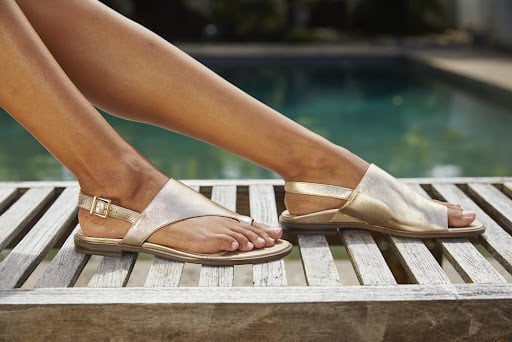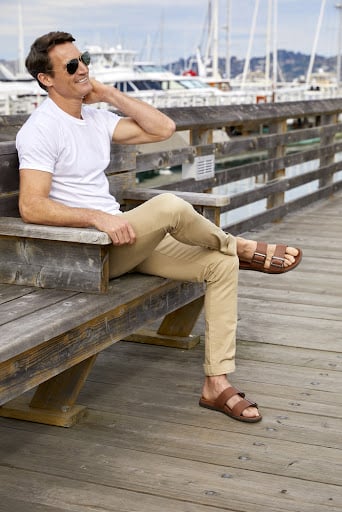Picture this: You wanted to wear women’s comfortable sandals for your upcoming vacation, so you ordered a pair of leather sandals. They were supposed to arrive a week ago, but they were late. Now you only have a day to break them and avoid blister blunders on the beach.
Whether this is your exact predicament or not, you’re probably looking for some extra wiggle room in your new walking sandals. If you’re wondering how to stretch leather sandals without damaging your new shoes, you’ve landed in the right place.
A Quick Note on Stretching Leather
Before you race off to try our sandal-stretching techniques, make sure you won’t cause any damage to your new kicks. While we think of leather as a singular material, there are actually several different types of leather.
Between leathers from different animals and variations in the tanning process, sandal manufacturers don’t always recommend the same methods for stretching.
All this is to say that you should research your footwear’s care instructions ahead of time. Always read the tags and literature that came with your sandals before attempting our stretching methods. You’d hate to find out the hard way that your leather-looking sandals aren’t even genuine leather at all!
5 Methods for Stretching Leather Sandals
Do you need sandals to wear with dresses immediately? Depending on how quickly you need your sandals stretched, there are several paths you can take. Some of our recommendations are below, but it’d be a stretch to say these are the only options.
#1 Visit a Shoe Repair Store
Sometimes it pays to leave the stretching to the experts, especially if you’re nervous about causing harm to your brand new sandals. Your local shoe repair shop likely offers professional shoe stretching for a small fee, and they can usually extend this service to leather sandals.
Professional stretching is typically offered as a same-day service. You can rely on a cobbler to increase your sandals’:
- Length
- Width
- Instep area
- Toe box height (applicable only to closed-toe sandals)
#2 Buy a Shoe Stretcher
Maybe you’re on a budget and have several pairs of leather sandals to stretch. Maybe you just prefer taking things into your own hands (or feet). Either way, a more cost-effective approach can be to purchase a shoe stretcher from a shoe store.
Home shoe stretchers are wood or plastic tools that you can place in the openings of your sandals. By slowly expanding the stretcher every night over a week, you can lengthen or widen just about any pair of leather sandals. Another option is to purchase a shoe stretch spray.
Shoe stretchers don’t cost much more than a professional shoe stretching or two, and you’ll have them for life—talk about a sound investment. Just remember that home shoe stretchers are most useful for men’s or women’s slide sandals without adjustable leather straps, such as the Demi Slide Sandal.
#3 Take a Stroll in Your Sandals
For a 100% free stretching option, there’s a natural way: wear them around. Slip on your new pair of leather sandals, and wear them to:
- The mall
- The park down the street
- The gas station
- The grocery store
- The yoga studio
With that said, be sure not to walk too far or for too long. Because your feet may take some time to adjust to your new sandals, we recommend only wearing new footwear for a few hours at a time during the first week.
Controversy Alert: The Socks and Sandals Approach
To speed up the natural stretching that occurs from walking, you can slip a pair or two of socks on before donning your sandals. You may draw some unwanted attention from passers-by, but increasing the overall “size” of your foot will help stretch the sandals out more quickly.
If you thought everyone was on the same page about socks and sandals as faux pas, think again. Believe it or not, wearing sandals with socks is now considered high fashion in some circles.1 If you’re into the socks and sandals look, the Charlie Slide Sandal might be the style for you.
#4 Work Your Sandals with Your Hands
No time for a neighborhood wander? No problem. You can work your sandals over with your hands, gently squeezing them and moving the leather back and forth. This technique replicates the friction that would normally come from walking. Plus, the natural oils in your hands help soften the material.
The benefit of manually working in your sandals is that you can focus solely on problem areas. If you’ve noticed specific parts of the sandal that chafe you while walking, spend some extra time massaging those areas. You may want to combine this stretching method with another if you’re finding these “hot spots” are a constant bother.
#5 Apply Some Gentle Heat
You might already know that if your leather sandals wind up wet, you should let them dry naturally instead of applying heat. But what about using heat for stretching?
Heat softens the leather, making it easier to mold into your ideal shape. If you’re careful, you can use a low amount of heat from the following sources to help stretch your sandals:
- Indirect sunlight
- A hairdryer on the lowest setting
- A low-power radiator
- Under-floor heaters
Take special care not to expose your sandals to high, direct heat (or to any source of heat for too long). Over time, heat can lead to cracks, dryness, or discoloration in leather.
Reasons to Stretch Leather Sandals
Now that you know how to widen sandals, you might be wondering when you’ll need to use this new skill. There are all kinds of reasons to lengthen or widen a pair of new sandals (or even a single sandal).
Popular motives for stretching leather or suede sandals include:
- Swelling – Whether you’re accounting for the natural expansion of your feet throughout the day or swelling due to diabetes, a little wiggle room never hurts.
- Hammertoe or bunions – These afflictions can make it challenging to find shoes that are the perfect fit. So, instead of buying them, make them. Light stretching can create extra space for bunions, hammertoe, and other foot-related concerns.
- Orthotics (for closed-toe sandals) – Unlike shoes, sandals don’t usually have a rubber sole you can remove to accommodate orthotics. Instead, you might need to stretch the material to make room for your orthopedic inserts.
- Sizing – When you find the perfect sandals only to discover they don’t sell half sizes, don’t despair! You might be able to buy a size down and stretch them slightly.
- Friction – If you notice that part of your sandal is rubbing and causing blisters, creating extra room can usually help solve the problem.
- Comfort – Frankly, stiff leather isn’t comfortable. There’s nothing like the feel of soft, worn-in leather—and the stretching process can bring you that feeling sooner rather than later.
Caring for Leather Sandals
Learning how to properly care for leather is essential for any shoe or sandal owner. But that importance doubles when you’re stretching your leather. Here are some quick tips for extending the life of your leather sandals.
Cleaning
When your sandals start to look dirty or dusty, a quick wipe with a damp cloth usually does the trick. Should the leather appear wet after cleaning, allow it to dry naturally. It is also important to remember that using rubbing alcohol can cause the leather to dry and strip the dye of the sandals.
For a more thorough clean, you can use a product like Vionic Leather Cleaner and Conditioner. On top of removing dirt and stains, a leather conditioner returns natural oils to leather, helping it last longer.
Note: Whenever you’re applying anything other than warm water to your leather sandals, be sure to test the solution on a small inconspicuous patch of the shoe. If the solution doesn’t affect the color or texture of the leather, you can safely apply it to the rest of the sandal.
Storage
When you store your sandals correctly, you’re extending their lifespan. Some best practices for storing leather include:
- Avoiding direct sunlight – It’s best to keep your sandals in a dark environment, as UV rays can cause the leather to fade or bleach.2
- Controlling temperature and moisture – Aim to store your leather sandals in a cool, dry place whenever you’re not wearing them. Extreme temperatures can damage the materials.
- Providing space – Once you’ve broken in your leather sandals, the material will be relatively soft. As such, it’s susceptible to becoming bent out of shape. Don’t stack other shoes on top of your leather sandals; allow them to breathe. If you plan to store them in a box or bag, pick something sturdy to ensure they won’t lose their shape. However, be sure to avoid using a ziploc bag or plastic bag because the vacuum might damage the leather sandals.
- Use shoe trees – Leather can return to its original dimensions when left unworn. Because sandals tend to be a seasonal shoe, you’ll likely go months at a time without wearing them (unless you’re lucky enough to live somewhere warm). By placing a wooden block called a “shoe tree” into the opening, you can make sure your sandals keep their shape.
Odor Elimination
Like all shoes, leather sandals can develop an unpleasant odor after frequent use. Odor in footwear is generally caused by microscopic fungi and bacteria.
The best defense against odor is a good offense—in other words, clean your footbeds regularly. To rid yourself of lingering odors, take a soft brush and scrub at the footbeds with warm, soapy water. Keep your sandals in tip-top shape by using a mild soap and allowing them to air dry.
Expand Your Shoe Collection, Not Your Shoes
Leather will naturally stretch a little over time, becoming more comfortable with age. But the best sandals feel phenomenal right out of the box.
At Vionic, that’s our goal. Most people find our supportive sandals comfortable the moment they slip them on. But if you do need to stretch a Vionic shoe, you can rest easy knowing that our high-quality leather won’t warp or break.
From dressy flat sandals for weddings to the best sandals for diabetics, you’ll find your foot’s new friend for the summer at Vionic.
Sources:
- Parker, Erin. “Socks With Sandals Are Essential for Snuggly Style in 2021.” Glamour. 2 February, 2021. https://www.glamour.com/story/socks-with-sandals
- “How Sunlight Affects Leather.” LeatherCult. 21 April, 2020. https://www.leathercult.com/blog/how-sunlight-affects-leather/




Leave a Reply